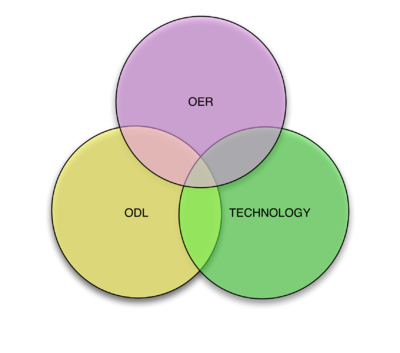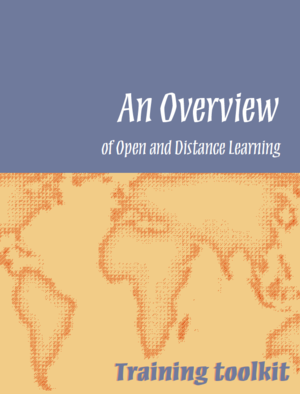OER and ODL
| OER Asia Workshop | ||
|---|---|---|
| Getting started | OER & ODL | Benefits of digitization | Towards a definition of OER | | Learning toolkit | |
Contents
OER in the context of ODL
| The objective of this module is to introduce you to two ideas and how they might fit with your intentions or those of your institution or government to enhance access and equity to learning in your communities. The workshop will also show how you can benefit from the enormous range of technologies and open educational resources (OER) that are becoming freely available for educators. |
Two big ideas
The first of the two ideas is the big idea of open and distance learning (ODL) which enables large numbers of citizens to participate in learning.
The second idea is the increasing use of technology to deliver education anywhere and anytime, in a flexible and cost-effective manner.
Open Educational Resources (OER) straddle both these ideas.
An overview of open and distance learning
There are many valuable resources available that describe the key concepts of open and distance learning (ODL). One of the best is a training toolkit titled An Overview of Open and Distance Learning that was produced by Commonwealth of Learning and the Asian Development Bank.
This toolkit[1]
TOPIC 1: Introduction to ODL
TOPIC 2: Operational Structures
TOPIC 3: Operational Issues
TOPIC 4: Course Planning and Development
TOPIC 5: Course Delivery and Learner Support
TOPIC 6: Quality, Research, and Evaluation
| Read and explore
Please read pages 1-1 to 1-16 of the training toolkit entitled An Overview of Open and Distance Learning. You are encouraged to read the rest of the handbook at your leisure as it contains useful information for those embarking on an open and distance learning (ODL) initiative. The pages that are recommended above support an introduction to:
Reflections
|
The five main features of ODL are:
- Separation of teacher and learner in time or place, or in both time and place
- Institutional accreditation; that is, learning is accredited or certified by some institution or agency
- Use of mixed-media courseware, including print, radio, and television broadcasts, video and audio cassettes, computer-based learning and telecommunications
- Two-way communication allows learners and tutors to interact, as distinguished from the passive receipt of broadcast signals. Communication can be synchronous or asynchronous
- Possibility of face-to-face meetings for tutorials, learner–learner interaction, library study, and laboratory or practice sessions
- Use of industrialised processes; that is, in large-scale open and distance learning operations, labour is divided and tasks are assigned to various staff that work together in course development teams
| ODL ideas which best fit your institution. Hint refer to the five features of ODL and compare these to distance learning practice at your institution. |
|---|
From your list, consider which ideas have worked well for you and which that have not. Can you give reasons why they have not worked?
|
From these lesson activities you should be able to describe the primary features of open and distance learning (ODL). Next, you will be exploring the idea of open educational resources (OER). After that you will explore how features of ODL and OER might be combined to provide enhanced educational opportunities for your students. |
Notes
- ↑ Any part of the training toolkit document may be reproduced without permission, but with acknowledgement to The Commonwealth of Learning and Asian Development Bank. Although it does not carry an open educational resource (OER) license such as a Creative Commons license, the training toolkit is free to use and reproduce for educational purposes

